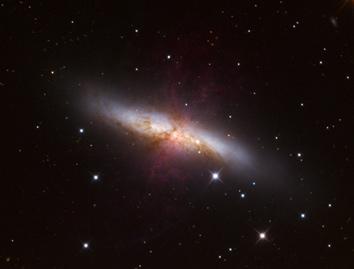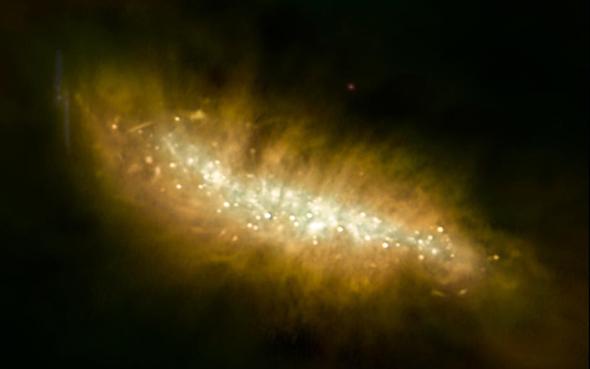I once saw a caterpillar that looked just like the picture above. And despite the somewhat staggering difference in scale, they have something else in common besides shape: They’re both decent metaphors for life cycles.
What you’re seeing in that remarkable shot is the galaxy M82, the host of the recent supernova SN 2014J. This picture was taken before that star blew up, though. M82 is a starburst galaxy, undergoing a huge wave of star birth. It’s producing something like 10 times the mass of the Sun of stars every year, many times what’s happening in our own Milky Way. Astronomers measure star formation rate in terms of the Sun’s mass, not number of stars, because the mass is easier to determine; a solar mass of material can create one star like the Sun, or many smaller red dwarf stars that are dim and hard to count (or a fraction of a big, hot star).
The image was taken by the Very Large Array, which detects radio waves, a low energy form of light. It focused on the inner region of M82, about 5’000 light years across (the entire galaxy is about 40,000 light years in diameter). This is where most of the star formation is occurring, and the fierce light of all these stars, born over the past 50 million years, is blasting out gas and dust from the galaxy’s core. What you’re seeing here is fast-moving gas moving outward, as well as light emitted by electrons spinning madly around the strong magnetic fields of the material there.

Photo by Adam Block/Mount Lemmon SkyCenter/University of Arizona
It really does look like a wave of material moving outward, which matches the view seen from optical telescopes, like the one here. That’s material getting flung away by the activity in the galaxy’s heart.
The bright dots in the radio image are a mix of gas clouds furiously forming stars and old supernovae that blew up long ago.
And that’s where this galaxy and my caterpillar overlap. In a galaxy like M82 (or ours for that matter), gas clouds form stars. Some of these are high mass, hot stars, which live short lives and explode. In their cores are heavier elements like iron, calcium, oxygen, and more, which get scattered into space by the explosion. This material slams into other gas clouds, which then form more stars, seeded with these heavy elements.
This happened in the Milky Way billions of years ago, and those elements from some long-dead star made their way into you. Your bones, your teeth, your blood, your very DNA have elements in them forged in the heart of a mighty star that violently tore itself to bits so that eventually you may live. It is a transformation on a literally cosmic scale.
I should hope the metaphorical metamorphosis is obvious enough. The only constant in the Universe is change, and much of it is a cycle. Birth, life, death, restructuring, and rebirth. That is also the theme of much of human art, from paintings and movies to myths and great novels.
Some say science is cold, dealing unemotionally with hard data. But that’s far from the reality. Humanity and life are reflected in the stars, and the Universe itself is poetry.
